![]()
![]()
![]()
Use LEFT and RIGHT arrow keys to navigate between flashcards;
Use UP and DOWN arrow keys to flip the card;
H to show hint;
A reads text to speech;
35 Cards in this Set
- Front
- Back
|
Brain functions/areas relating to language and literacy |
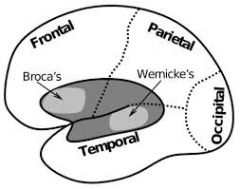
1) Occipital lobe: at the very back of the brain, holds the primary visual cortex. 2) Frontal lobe: Largest area in the left hemisphere of the brain. 3) Temporal lobe: lower portion of the brain, almost near the ears or your temples. 4) Left parietotemporal system: This system helps the brainprocess language with and between the lobes. 5) Left occipitotemporal system: This system also operates within and between the lobes to provide automatic, rapid access to whole words, and thus directly affects fluency. 6) Parietal lobe: This lobe is positioned further back in the brain and affects sensory perceptions to help us translate spoken and written language to meaning. 7) Wernicke’s area: within the temporal lobe, discovered by Carl Wernicke. 8) Broca’s area: Named for Paul Broca, this area is in thefrontal lobe. 9) Fusiformgyrus: part of the temporal lobe and occipital lobe. Though thefunctionality of the fusiform gyrus is not fully understood, it has been linkedto recognition and it has been linked to dyslexia.wC |
|
|
Where (roughly) is the occipital lobe, name one important function. |
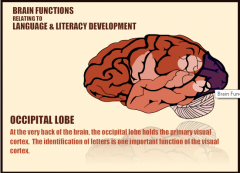
The occipital lobe holds the primary visual cortex.
The identification of letters is one important function of the visual cortex. |
|
|
Where (roughly) is the frontal lobe, name one important function. |
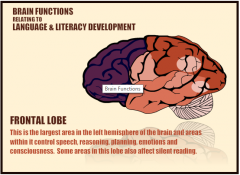
Frontal lobe: Largest area in the left hemisphere of thebrain; controls speech, reasoning, planning. Some areas in this area alsoaffect silent reading. |
|
|
Where (roughly) is the temporal lobe, name one important function. |
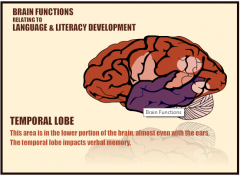
Temporal lobe: lower portion of the brain, almost near theears or your temples. The temporal lobe impacts verbal memory |
|
|
Where (roughly) is the left parietotemporal system, name one important function. |
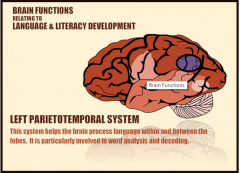
Left parietotemporal system: This system helps the brainprocess language with and between the lobes. It is particularly involved inword analysis and decoding. |
|
|
Where (roughly) is the left occipitotemporal system, name one important function. |
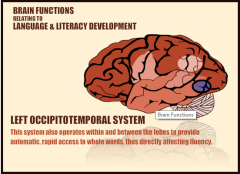
Left occipitotemporal system: This system also operateswithin and between the lobes to provide automatic, rapid access to whole words,and thus directly affects fluency. |
|
|
Where (roughly) is the parietal lobe, name one important function. |
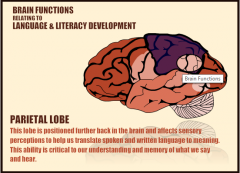
Parietal lobe: This lobe is positioned further back in thebrain and affects sensory perceptions to help us translate spoken and writtenlanguage to meaning. This ability is critical to our understanding and memoryof what we say and hear. |
|
|
Where (roughly) is Wernicke's area, name one important function. |
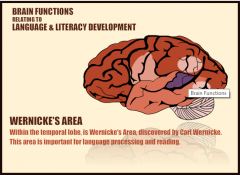
Wernicke’s area: within the temporal lobe, discovered byCarl Wernicke. This area is important for language processing and reading. |
|
|
Where (roughly) is Broca's area, name one important function. |

Broca’s area: Named for Paul Broca, this area is in thefrontal lobe. It is important for the organization and production of speech. |
|
|
2 ways to get reading disorders |
Acquiredreading disorders: 1) Acquired dyslexia results in the loss ofliteracy skills as a result of some form of trauma to the brain 2) Phonological dyslexia; surface dyslexia; deepdyslexia Developmentalreading disorders: 1) Developmental dyslexia 2) Poor reading comprehension 3) Difficulty in acquiring literacy skills |
|
|
What can acquired reading disorders result in? |
Acquired reading disorders: 1) Acquired dyslexia results in the loss of literacy skills as a result of some form of trauma to the brain 2) Phonological dyslexia; surface dyslexia; deep dyslexia |
|
|
What can developmental reading disorders result in? |
Developmental reading disorders: 1) Developmental dyslexia Individualswith developmental dyslexia have difficulties with accurate and/or fluent wordrecognition and spelling, despite adequate instruction and intelligence andintact sensory abilities. |
|
|
What is an acquired reading disorder? |
A disorderthat is the result of some form of brain injury, operation or illness whichcauses brain damage. This damage results in the loss of, or disruption to, someparticular skills that were functioning normally before the injury or illness. Had an ability and then lost it. Usually in adult population or in teenagers |
|
|
What is a developmental reading disorder? |
Developmental reading disorders are disorders that do notresult from any obvious trauma, but where the normal development or acquisitionof a skill (e.g. spoken language, literacy) is affected. Difficulty acquiring a skill -- never got to a certain level. Usually young. |
|
|
What are the 4 types of acquired dyslexia? |
Phonological dyslexia = severe phonological difficulties,unable to read unfamiliar and non-words Surface dyslexia = less severe phonological difficulties,able to read regular words and non-words, but unable to read irregular wordsDeep dyslexia =severe phonological difficulties, unable to read non-words, difficulty withfunction words and makes lots of semantic errors Non-semantic reading = read word without understanding theirmeaning |
|
|
What is phonological dyslexia? |
= severe phonological difficulties, unable to read unfamiliar and non-words. GPC route -- rely on sight vocab and go through lexical route. Try and retrieve (reading by analogy) draw on something they know, cannot break it down. |
|
|
What is Surface dyslexia? |
= less severe phonological difficulties, able to read regular words and non-words, but unable to read irregular words. Preference to reading via non-lexical words. Always decode and sound out each word. Problems with lexical hermits and irregular words. |
|
|
What is Deep dyslexia ? |
= severe phonological difficulties, unable to read non-words, difficulty with function words and makes lots of semantic errors |
|
|
What is Non-semantic reading dyslexia? |
= read word without understanding their meaning |
|
|
What are cognitive models of single word reading trying tocharacterize? |
Attempt to characterize the mental processes involved inidentifying, understanding, and pronouncing written word. |
|
|
A model of single word reading must include what four types of words? |
1) Regular words 2) Irregular words 3) Unfamiliar (real) words 4) Pronounceable non-words |
|
|
Name two cognitive models of single word processing. |
Dual-routemodel: parallel processing and serial processing Connectionistmodel: only parallel processing |
|
|
What are two ways we can convert words into sounds? |
Lexicalaccess: irregular words require lexical access, i.e. we need to go throughthe lexicon to retrieve the sound of a word. This must also involve reading viameaning. GPCprocess: non-words are read via a GPC process (non-lexical or sub-lexical)which involves phonological recoding, and not lexical access. |
|
|
Tell me about the Dual-route model: |
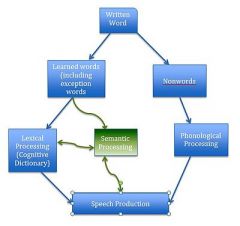
Two routes for reading a word. Case studies conducted on individual with acquired dyslexia. direct route (lexical): parallel processing (up and down,activated left and right) |
|
|
What are the lexical procedures for reading in the dual-route model? |
Lexicalroute: a direct route via the lexicon (retrieves previously learntinformation from lexicon) Lexicalsemantic: used for familiar words, homographs Lexicalnon-semantic: used for irregular words |
|
|
What are the non-lexical procedures for reading in the dual-route model? |
Non-lexical:applies rules for pronunciation of letters, used for unfamiliar words and pronounceable non-words. Purely decoding. |
|
|
Criticisms of the dual route model |
Does not accommodate reading fluency GPC rules will only generate correct pronunciation for regular words where spelling corresponds with phonology Will not generate correct pronunciation for irregular words or lexical hermits Helps us understand the processes in reading, but does not specify how the processes take place. |
|
|
Describe the basic principles behind the connectionist model |
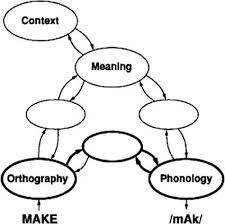
Composed of simple representational units callednodes |
|
|
The connectionist model suggest that readers learn associations between print and sound at 3 levels. What are they? |
1) Individual letters and phonemes 2) Letter groups and syllables 3) Print and sound at the whole word level |
|
|
Tell me about the connections between levels in the connectionist model. |
connections between levelsare bi-directional and excitatory (if one node is activated then it activatesall its neighbors). |
|
|
Explain how one might read the letter "F" in the connectionist model |
1) Individualletters and phonemes (feature)When you see the letter “F” you see the vertical bar, and activate otherletters with a vertical bar, such as H, T, F, L 2) Letter groupsand syllables (letter) The active letters inhibit other letters that do not share the same feature ofa vertical bar, like A, O, and C. 3) Print and sound at the whole word level(word) The active letters provide excitatory input tothe word level and those words that contain that letter in that position becomeactive. This process continues until only one word is active at the word level. |
|
|
Tell me criticisms of the connectionist model: |
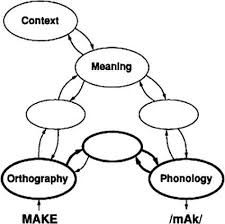
Focus on monosyllabic words |
|
|
Summarize the difference between the dual route (DRC) model and connectionist models. |
Dualroute (DRC) model: Emphasizes regularity i.e. does the word obey the rule(= categorical concept) |
|
|
How do we link the brain to models of cognitive processes? |
Neuroimaging (FMRI + ERP) |
|
|
Where (roughly) is the fusiform gyrus, name one important function. |
Partof the temporal lobe and occipital lobe. |

